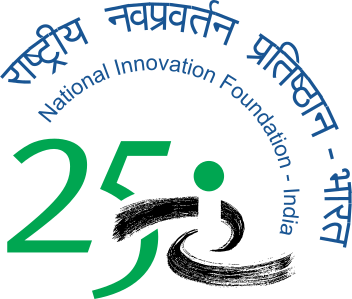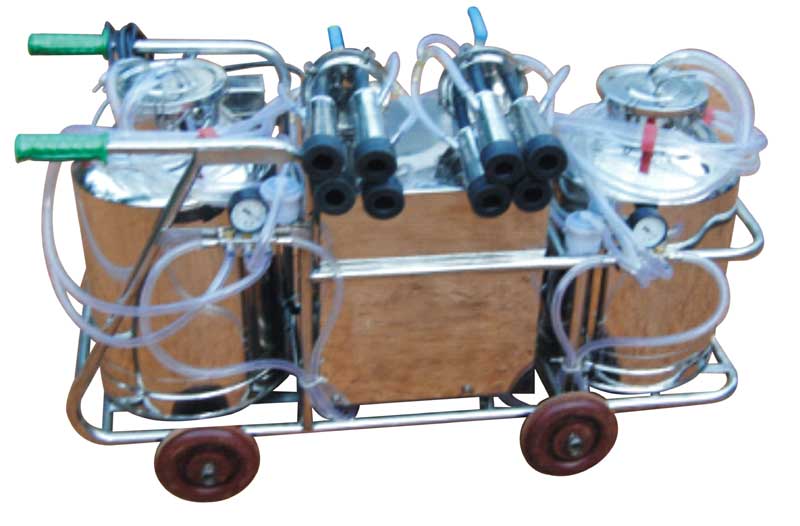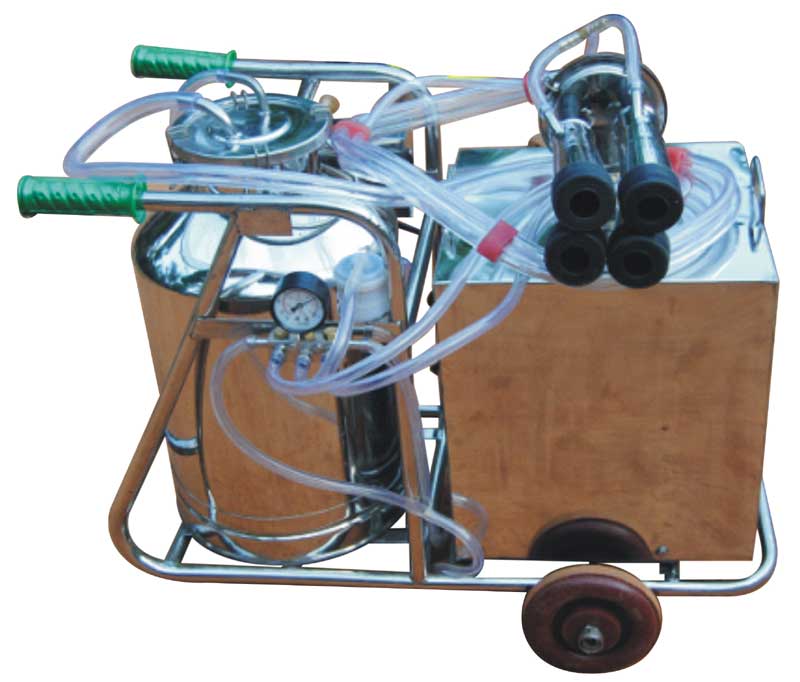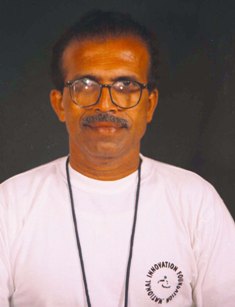Safe milking of cow/buffaloes is a requirement across rural India. In rural India availability of skilled labor for milking is also a problem now days. Adding to this is the fact that milking by hand is not considered healthy or hygienic anymore. Power operated milking machines are available in the market which are very expensive, suitable and affordable only for large cattle farms.
Innovator has made a manually operated as well as a power-driven milking machine that helps small farmers to milk animal hygienically and reduce the drudgery in the process. It is a very simple machine and can be easily operated by women as well.
Raghava Gowda hails from Pallathadka, Murulya village in the Sulya taluka of South Canara district in Karnataka. A schoolteacher by profession, he is 52-years-old and is brimming with ideas that would help solve various problems faced by members of his community. His father was also a schoolteacher. He acknowledges the support provided by his family throughout the process of innovation. He attributes his success to willingness to work hard, kindness and truthfulness to his parents. These virtues according to him have contributed a lot to his growth as an individual. Raghava is respected and held in high esteem, and his innovations are by now legendary in his village.
Genesis
Finding skilled labour for milking a small herd of cows is a problem often faced by a small-time farmer. Adding to this is the fact that milking by hand is not considered healthy or hygienic anymore. But milking using a machine is a luxury which only a large farm or dairy house can boast of, calling for a huge investment in power supply and machinery. All of these set school teacher-farmer, Raghava Gowda, thinking very hard about developing an alternate means of mechanized milking which would be affordable to all farmers.
A keen observer and a fast learner, Gowda observed the working of the Gutter spray pump, used for spraying pesticides. He came up with the idea of using PVC teat cups and a plastic pipe on the Gutter pump. Thus he developed the first machine and began experimenting on his own farm. But for this the teat cup had to be moulded according to the size of the teat and he had to heat the PVC pipe. But milking using this device proved to be quite painful for the cow as an excessive vacuum was created. To solve this problem, a vacuum container was adapted. With this addition, milking could be done from four teats. Experimenting with it further he switched over to a foot press. Then he fitted the vacuum pump on a four legged fabricated frame which later was replaced by a three-legged frame to provide stability. A vacuum level gauge was provided to know the level of the vacuum generated. To reduce the strain on the operator he then tried out a gear and wheel vacuum pump set-up. A stainless steel can, lid and stainless steel junctions for the teat adaptors were also introduced. Further trials resulted in reducing the milking effort by adopting alternate pulsing for each set of two teats and by reducing stroke and diameter of vacuum pump. It took him four years of hard work and 15 models to finally arrive at the successful milking machine, which costs less than Rs.7000/- and at last Raghava is satisfied that the machine is problem free.
Raghava has developed an elaborate, refined milking machine that can milk cows and buffaloes using a set of reciprocating vacuum pumps with a vacuum gauge, a suction assembly unit and an air bubble free well gasketed milk canister to receive the milk. The suction assembly has two sub-assemblies with a set of nipples and stainless steel plate on one side and transparent conduit pipes and a regulator valve on the other.
Each of the sub-assemblies are taken apart for cleaning before and after every milking operation.The udder and teats of the cow are also washed with cold water and wiped using cotton cloth. The hand lever attached to the pumping unit is cranked till a vacuum of 200-250 inches is created in the suction–nipple unit. This is attached to the udders and the milk gets deposited in the receiving canister via the transparent conduit pipes. When air bubbles flow along with the milk, the operation is stopped and on gently pressing the top of the teats, the teats get released. The control valve and vacuum pressure gauge, located on the main pumping unit, control the suction circuit and the milk receiving canister via the transparent conduit pumps. The four nipple suction configuration can alternate pulsations between two sets for the operation for facilitating milk flow and reducing milking time.
Good publicity in the press helped and soon his phone was ringing off the hook, with frantic and urgent enquiries about the milking machine. This is now widely used and appreciated by small-scale diary farmers in his area. As of date he has sold 170 machines and has another ten orders in hand from states like Andhra Pradesh and Tamil Nadu also.
He has got good responses from universities, banks & other government agencies. The University of Agricultural Sciences, Dharwad, had given him a certificate during the Krishimela. The Syndicate bank, Hiriyadka, also has given a certificate in appreciation of his innovation. But so far he has not been approached with any business enquiries or for licensing the technology.
Advantage
The advantages of this milking machine are manifold. It is easy to operate, costs low, saves time as it milks 1.5 litre to 2 litres per minute. It is also very hygienic and energy-conserving as electricity is not required. All the milk from the udder can be removed. The machine is also easily adaptable and gives a suckling feeling to the cow and avoids pain in the udder as well as leakage of milk.
A life-long innovator…
Raghava had started innovating at the tender age of ten when he fashioned a Spray Gun out of bamboo and a noodle-press which was followed a couple of years later by a bamboo pump. His resume of innovations also include a rotating toy using heat and light, a Gobar gas plant using plastic and PVC spares. Improving his innovations has always been a priority for him as he devised a method to improve the productivity of gobar gas using two drums and he also ran an engine using the gas. He has also won an award for creating an artificial Queen Bee and his interview was broadcast on AIR, Mangalore.
Experiments at his farm:
He has developed a sprayer which can machine spray areca trees. This sprayer uses a gutter pump with a control mechanism in hand and costs about Rs.350. It is easy to use, assemble and dismantle and he has been using it for the last 12 years. He claims the method is cost effective and efficient and that the sprayer can spray in a 360° direction and to a distance of 20ft that can cover around 20 areca plants.
He has developed a fodder cutter that slices even hard fodder material like coconut and Areca Palms easily. He claims that the present fodder cutter he is using is unique and more efficient and safer to handle and that he developed it six years back. Now he has developed a new model with some modifications and is selling it at a cost of Rs.750.
Raghava Gowda also practises many alternative as well as resource saving technologies as part of his daily life. He uses solar energy to light the lamps in his house. For this he has installed two solar panels on the rooftop and charges 24 volts batteries. He practices multi-crop farming and has 15acres of well irrigated farm with lust greenery. His farm consists of a variety of plans of both horticultural and medicinal importance and he claims that for the past 14 years he hasn’t used any chemical fertilizers in his farm. He uses the waste slurry as manure for the plants in his farm. An advocate of rainwater harvesting, he effectively uses the run-off water to charge his own bore wells.
Future plans and dreams…
Raghava’s aim is to make his milking machine available to dairy farmers at a cheaper rate. But he is quite sure that he does not want to sit back and enjoy the success of his “Milk Master”, but would prefer to dedicate his time to developing the following innovations which are currently in a conceptual form- easy methods of bee-keeping, a gas water heater and an automatic water dispenser for a cattle shed.
Innovator has been awarded in the 3rd National Award Function of NIF (2005) and also supported under MVIF scheme of NIF. Apart from India, the innovator has also sold machines to customers in Philippines, Uganda, and Ethiopia and also set up an office in
Patent Granted in India (patent no: 204471)
The machine is available in four variants – 1) Manually operated (Hand Driven) 2) Semi Automatic Single cluster AC motor driven 3) Semi Automatic Double AC Motor Driven and 4) Semi Automatic 12 V DC battery operated. All these models are made from Food Grade Stainless Steel material and equipped with Cluster assembly with four teat adapters with silicon rubber teat liners, transparent milk, and vacuum pipe. 100-gram vacuum grease and two O-rings are provided as spares. In this entire model, the vacuum level required for milking is 350 mm Hg. The model wise technical details are as below.
Model: 1 Manually operated Hand (Hand Driven):The weight of the machine is 18 kg, it does not require any external power source and it can milk one animal at a time. It is a basic milking machine, mounted on stainless steel frame. It is having two reciprocating vacuum pump linked to a handle for manual back and forth operation. Milking machines are made of food grade 304 stainless steel sheets.
Model: 2 Semi-Automatic Single Cluster AC Motor Driven: The weight of the machine is 35 kg, its power requirement is 180W (220 V Single Phase) and it can milk one animal a time. This Milking machine is driven by AC geared motor, through a linkage. The Machine is mounted on a stainless steel trolley having polymer wheels. The trolley can be dragged easily in cow shed. The machine can be operated manually by handle in emergency. It includes two reciprocating vacuum pump linked to 180 watt single-phase electrical geared motor. Milking machines are made of food grade 304 stainless steel sheets.
Model 3: Semi-Automatic Double Cluster AC Motor Driven: The weight of the machine is 50 kg, its power requirement is 180W (220 V Single Phase) and it can milk two animals at a time. It consists of two Control block with vacuum gauge, two 20 liters Milking can made of food grade 304 stainless steel sheets and two Cluster assemblies with four teat adapters with silicon rubber teat liners. The other specifications are same as model no. 2.
Model 4: Semi-Automatic 12 V DC Battery-operated: The weight of the machine is 33 kg, its power requirement is 150W (Battery operated, rating 35 A, 12 V, can run for 1.5 hrs continuously and it can milk one animal at a time. The other specification are same model no: 2.
- The average time of milking is 4-6 minutes per cow
- Easy to operate , Saves time and effort in milking (1.5 litre to 2 litres per minute)
- Hygienic and complete milking
- Machine is easily adaptable and gives soothing feeling to the cow
- Machine runs smoothly for 8 - 9 years









